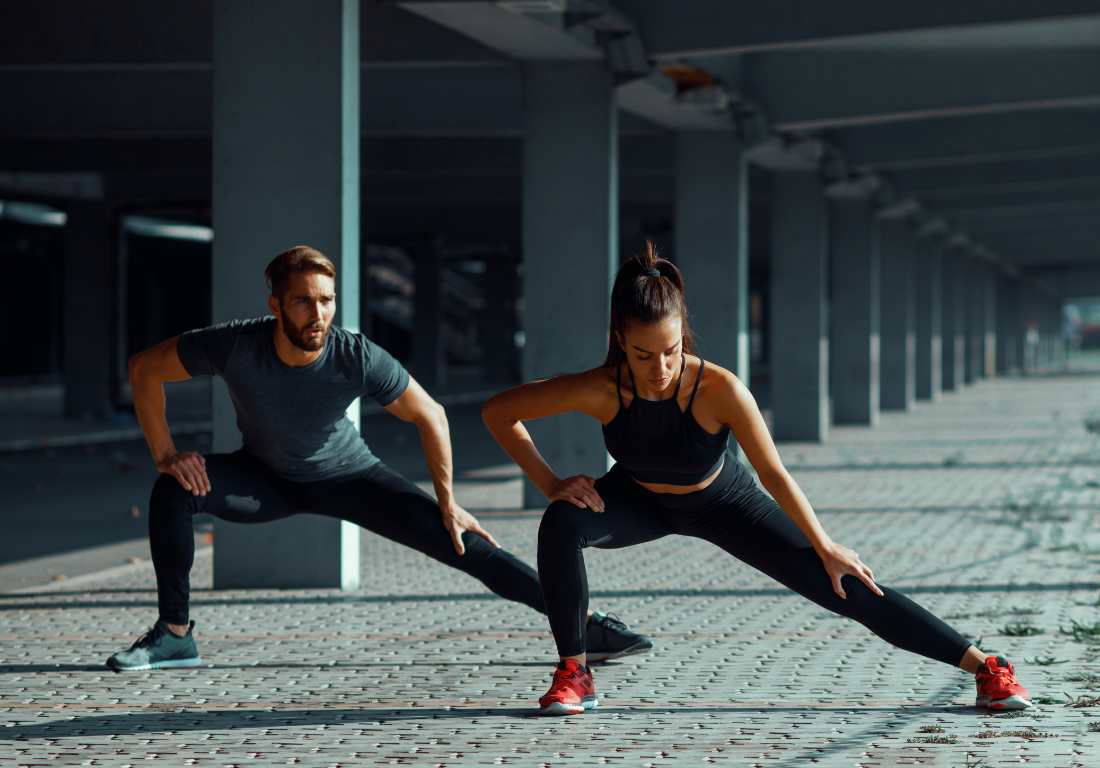
Top 10 Adductor Stretches to Ease Tightness
You’ve landed here, so chances are you’re experiencing some tightness in your inner thigh muscles and are after an adductor stretch.
Read on, my friend!
Table of Contents
- What Does Stretching Do?
- Anatomy 101
- What Causes Tightness? How to Relieve it
- Can I Do an Adductor Stretch With Groin Pain?
- Top 10 Adductor Stretches
- Summing Up
What Does Stretching Do?
Get ready for your mind to be blown!
Despite what many people believe, stretching does not lengthen the muscles or tendons. What?! So then what’s actually happening?
Stretching works by changing your body’s perception of safety. This means that your adductor muscles are not actually shortened (unless you have a contracture caused by a neurological condition), instead, your body is choosing to keep them contracted in an attempt to protect you from injury, often unnecessarily.
Stretching our muscles to a point of feeling tension, but not pain, tells the body that it is safe to relax these muscles a little, which then results in you feeling like your muscles have been stretched to be longer.
It works by prompting the tissues to have increased extensibility due to an increased tolerance to the stretching force we are consciously exposing them to. This means that the relief you feel after stretching is due to sensory changes.
Both long-hold (static) stretching and contract-relax stretching have been shown to increase the extensibility of certain muscle groups in both the short and long term.
What Stretching Doesn’t Do
I want to highlight that stretching of any kind hasn’t been shown to relieve muscle soreness after exercise or a workout, regardless of whether you do the stretches before or after your session.
Static stretching also doesn’t help prepare your body for performance, with some studies actually showing that it can reduce muscle strength and power when done before a sport or workout.
Jump to the Top 10 Adductor Stretches

Another read that might interest you: Should you do yoga before or after a workout?
Anatomy 101
The adductor complex is a group of muscles that have a role in stabilising the pelvis during movements like walking, running and jumping. Being stabilisers, they’re often not using their full available range of motion.
This, combined with overloading during workouts or weakness resulting from a sedentary lifestyle, can lead to the body choosing to tighten these muscles in an attempt to keep the body safe and working as efficiently as possible.
The adductor group is made up of five muscles, all of which begin at the pubic bone, and then attach at various parts along the thigh bone (except for gracilis). They are listed here from shortest to longest:
- Pectineus – The smallest and therefore weakest adductor muscle, nestled high up in the groin
- Adductor brevis – Only slightly larger than pectineus, so still a weak adductor of the hip
- Adductor longus – A large, fan-shaped muscle sitting in the middle of the adductor complex
- Adductor magnus – The largest and strongest muscle of the adductor group, which also acts with the hamstrings
- Gracilis – The longest adductor muscle and the only one that crosses the knee joint, attaching to the shin bone
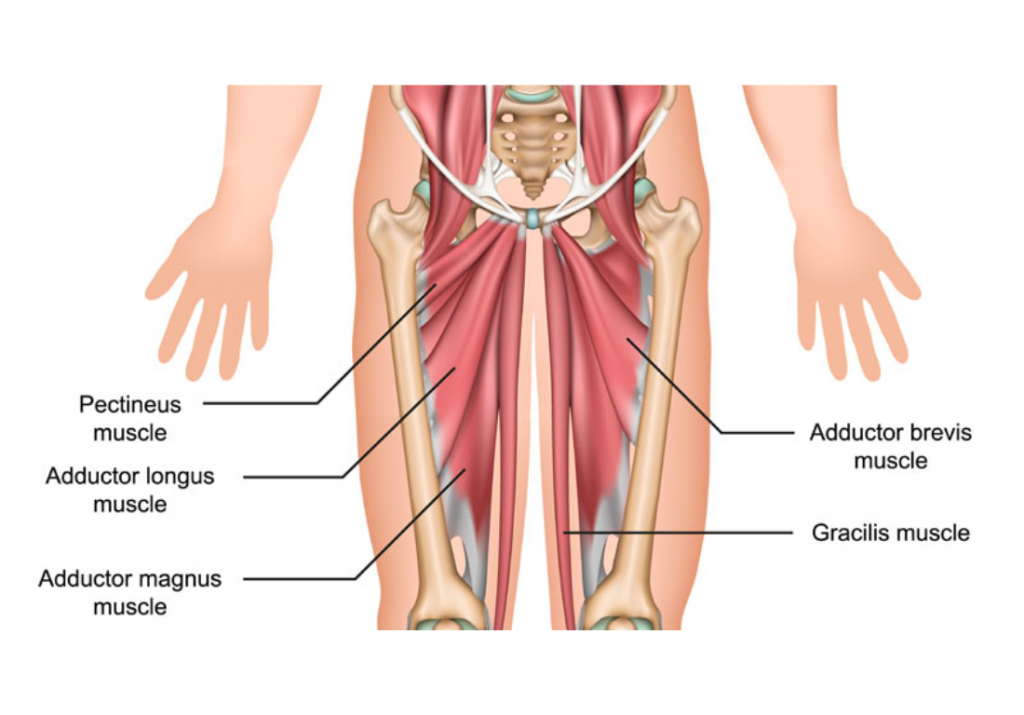
Jump to the Top 10 Adductor Stretches
What Causes Tightness? How to Relieve it
Tightness, unless you have a contracture, is the body’s way of attempting to keep a structure safe, even if it’s uncomfortable for you. The perception of tightness is subjective, as ballet dancers who can touch the floor may also report ‘tight hamstrings’, for example.
Reasons for feeling tightness are generally multifactorial with contributors including:
- Muscle weakness
- Overtraining
- Nutritional deficits
- Lack of quality sleep
- Stress
- Specific neurological conditions
Stretching
Stretching has been shown to ease tightness both in the short and long term by prompting sensory changes in the muscles.
A recent, comprehensive study (a systematic review) found that there were no differences between strength training and stretching when it came to improving joint range of motion. This guides us to suggest that either modality can be used based on a person’s preferences.
Static Stretches
- When you hold a stretch for an extended period of time without moving
- Are best done after sport or a workout as opposed to before as that can impede performance, especially if held for longer than 60 seconds
Contract and Relax Stretches
- These are static stretches with muscle contraction added
- It involves going into a stretch for a short hold, contracting the muscle you’re stretching for 5-15 seconds, and then relaxing back into the stretch again
- Generally, you’ll repeat this 3-5 times.
Dynamic Stretches
- These are movements that take a muscle to its end of range
- They are faster movements designed to get the body warmed up
- There’s some evidence to suggest that doing more than 2 minutes of dynamic stretches before a sport or workout can improve performance
Foam Rolling
Adductor release work is another way to ease the feeling of tightness in this area. It works in a similar way to stretching in that it generates sensory changes to ease the sensation of tightness. Favourable effects are best seen when you foam roll the adductors for more than 60 seconds.
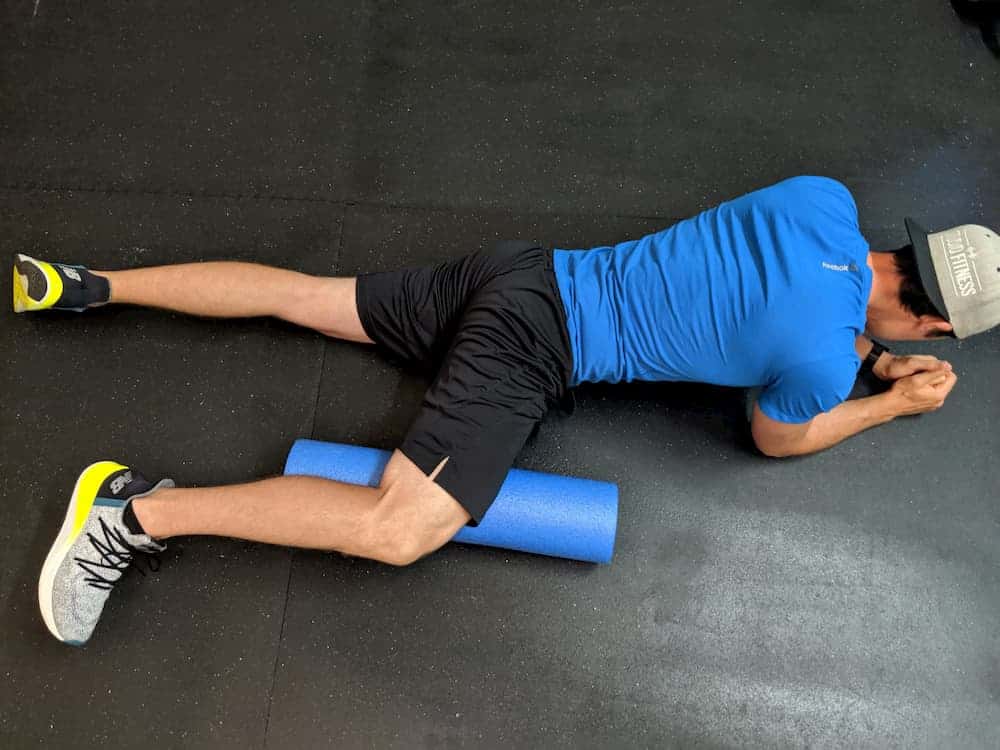
Strength Training
As mentioned above, strength training has been shown in a recent systematic review (a large, comprehensive study) to be just as good at improving joint range of motion as stretching. It also has the added benefit of strengthening the area which is great since weakness can be a reason for feeling tightness in the first place.
Examples of adductor muscle strengthening exercises are ball squeezes between the knees, side-lying hip adduction, Copenhagen side planks and Cossack squats. Not sure what they are? A quick Google search will be able to show you!
Jump to the Top 10 Adductor Stretches
Can I Do an Adductor Stretch With Groin Pain?
Groin pain can occur for different reasons at different stages of life depending on skeletal maturity and the type of activity that someone is doing. This also means that groin pain can be coming from a variety of sources within the body.
With any pain, as easy as it is to try to find quick fixes via a Google search, I encourage you to seek the help of a rehabilitation professional as stretches alone will not be enough to help, or they may not be advised at all.
Here’s a quick overview of the types of pain that can be felt in the groin:

Adductor muscle pain
Pain or tightness originating from the adductor muscles is most likely the reason you’re here. It is generally characterised by pain around the pubic bone and the inner thigh, which usually worsens when stretching the adductor muscles.
An adductor or groin strain is when a portion of the muscle has a tear in it, usually from being stretched too far or contracted too quickly under load. If you have a fresh adductor strain, do not stretch the adductor muscles for the first week at least and go never stretch into pain. I would also highly advise getting guidance from a rehabilitation professional as stretching could worsen your injury or prolong your recovery. Strengthening will be an important part of your recovery to prevent re-injury.
Pubic bone pain
Pain in the pubic bone is generally very localised as it involves the joint at the front of the pelvis. Adductor muscle tightness often accompanies it, and pain is usually worsened when using the adductor muscles such as if you squeeze your knees together.
Pubic bone pain is very common during pregnancy due to the increased movement in the pelvis in preparation for birth. Adductor stretches and foam rolling can be great for public bone pain to relieve tension in the muscles that attach to the area. Just ensure you listen to your body. If pain is worse after stretching or foam rolling, it may not be the best idea. With any pubic bone pain, I always recommend seeking advice from a rehabilitation professional.
Inguinal pain
Pain in the inguinal region, which is just above the groin, may be indicative of an inguinal hernia. Pain is generally worse with activity, as well as actions such as coughing, sneezing or sit-ups. Adductor stretches will not help with inguinal pain. I advise you to speak to your doctor about getting this investigated.
Hip flexor pain
Groin pain coming from the hip flexors is more felt at the front of the hip than the inner thigh and is generally worsened by stretching or working the hip flexor muscles. You may or may not get relief from adductor stretches as they don’t target the hip flexor muscles.
Hip joint pain
Hip pathologies or injuries can cause pain in the groin as well as the buttock region and thigh. Pain may also be accompanied by mechanical symptoms such as the joint locking, clicking or giving way. Examples of hip joint pathologies are hip osteoarthritis or femoroacetabular impingement (FAI). Depending on what joint positions are problematic, inner thigh stretches may or may not provide relief. I encourage you to consult with a rehabilitation professional for tailored guidance.
Top 10 Adductor Stretches
Alright, here they are! My top 10 stretches for your inner thighs. You can easily do these adductor exercises at home as no equipment is needed.
They can all be done as a static stretch (long hold), and most can have a muscle contraction added or be made into a dynamic movement, as you’ll see. Be sure to read the guides below on frequency and tips for best results.
NOTE: They are listed in order with #1 being the most gentle adductor stretch, and #10 being the most intense.
Which Ones Should I Do? How Long For? How Often?’
- The stretches are listed in order from the most gentle (#1) to the most intense (#10)
- Begin by choosing 3 of the stretches
- Spend 1-2 minutes on each adductor stretch
- Begin doing the stretches every 1-2 days, depending on how your body responds
- Progress by:
- Adding more stretches to your routine
- Moving to the more intense stretches
- Progressing stretches to twice a day if you feel it will benefit you
Tips For Best Adductor Stretch Results
- Do them when the body is warm: this could be after a workout, walk or run, or mean that you do 5-10 minutes of lower body movements before getting started
- Ensure you keep breathing throughout instead of holding your breath
- Listen to your body – don’t push a stretch into pain or hold for too long if it’s not feeling good
1. Sumo Squat Adductor Stretch
- Stand with your feet wider than hip-width apart
- Bend into a squat and place your hands or elbows on your knees
- Push your knees outwards with your arms to explore this stretch
To make this more active:
- Add in a muscle contraction by pushing your knees in towards each other, against your elbows or hands, for 5-15 seconds and then relax back into the stretch, repeating 3-5 times
- Add movement by cycling between this squat hold position and then standing up tall with straight legs so you’re coming in and out of the squat stretch repeatedly

2. Butterfly or Bound Angle Pose
- Sit on the floor and lean back on your hands
- Bring the soles of your feet to touch at a position that feels comfortable for you. The closer your feet are to your body, the more intense the stretch.
- Allow your knees to drop down towards the floor
- If it’s available to you, you can sit up tall and place your hands on your feet, or even drop into a forward fold over your legs
To make this more active:
- Add a muscle contraction by placing your hands or elbows on your knees, pushing your knees up into your arms for a 5-15 second hold, and then moving back into the stretch, repeating 3-5 times
- Add movement by bringing your knees in toward each other and then dropping them back out to the starting stretch, like you’re ‘flapping the wings’ of the butterfly
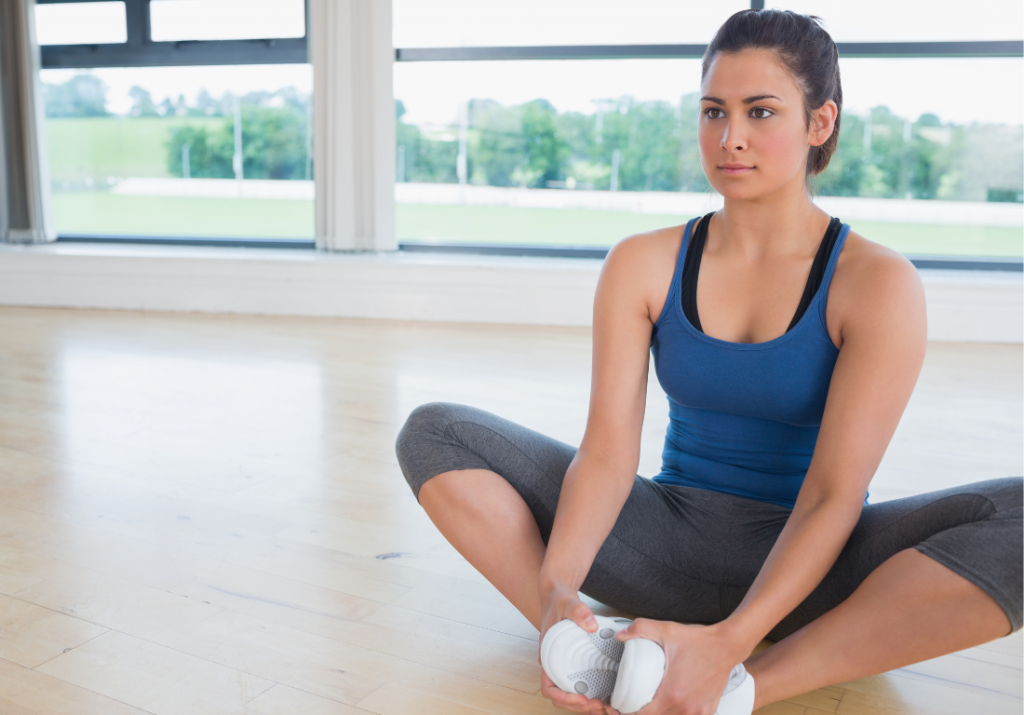
3. Half-kneeling Adductor Stretch
- Kneel up high on your knees on the floor (don’t sit on your heels), placing a towel or mat under your knees for comfort if needed
- Straighten one leg out to the side to begin to feel a stretch in the inner thigh
- Take it further by placing your hands on the floor and sitting your buttocks backwards towards the foot behind you
To make this more active:
- You can add movement by rocking your body back and forth with the support of your hands
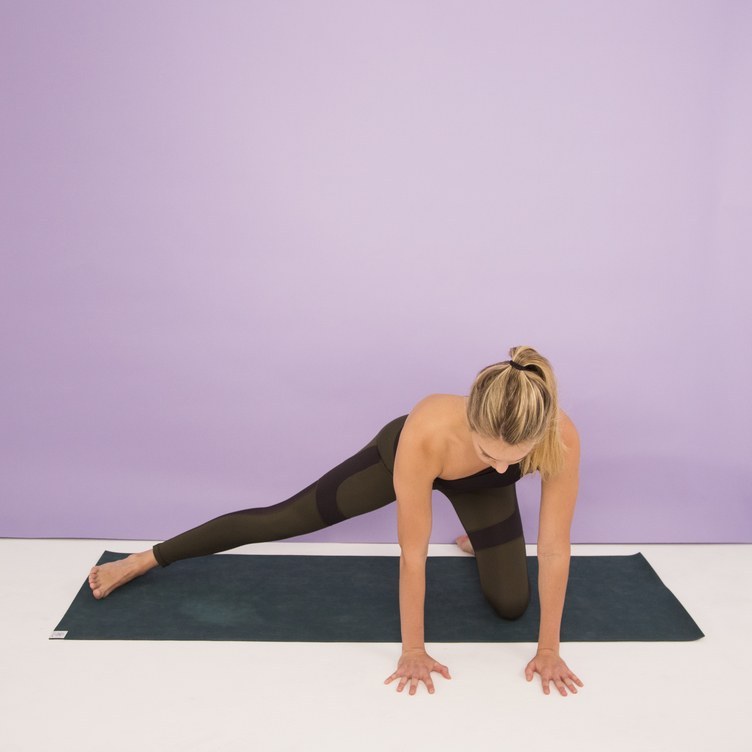
4. Standing Wide-Leg Forward Fold
- Stand with your legs nice and wide, much wider than hip-distance apart
- Bend forwards to place your hands on the floor or a low, stable object like a small table, chair or yoga block
- If it’s available to you, you can continue folding, taking your head towards the floor
To make this more active:
- You can add in movement by bending one knee whilst keeping the other straight, taking yourself into a side lunge (see next stretch). You can do the same side repeatedly or alternate sides.
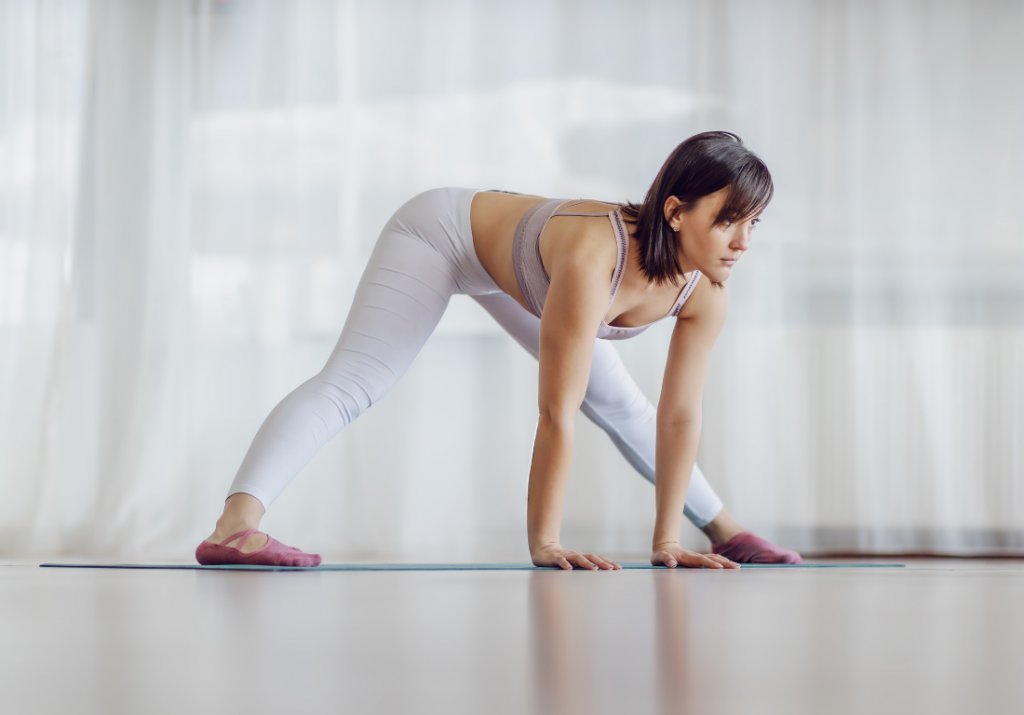
5. Side Lunge Variations
- Stand with your legs wide, much wider than hip-width apart
- Bend one knee and sit your hips back behind you so your weight is in your heel. You can support yourself with your hands on your bent knee if needed.
- If it’s available to you, you can continue dropping the hips down until you’re in a deep side lunge (skandasana in yoga), placing your hands on the ground for support if needed
To make this more active:
- Add movement by returning to standing up tall and then dropping into the lunge again, repeating on the same side or alternating sides
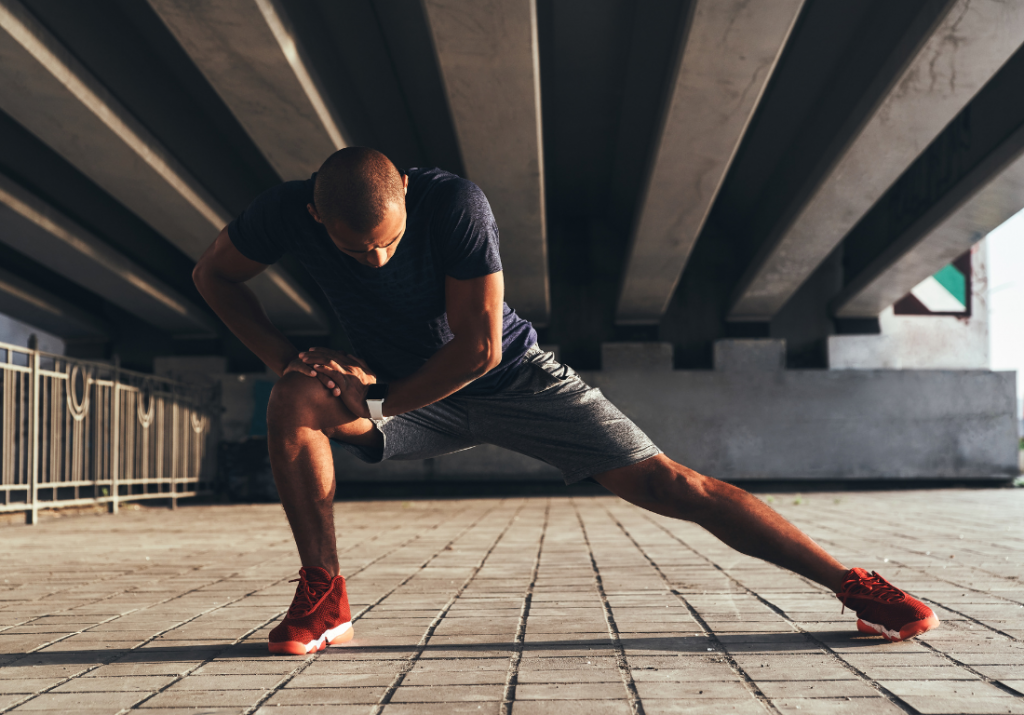
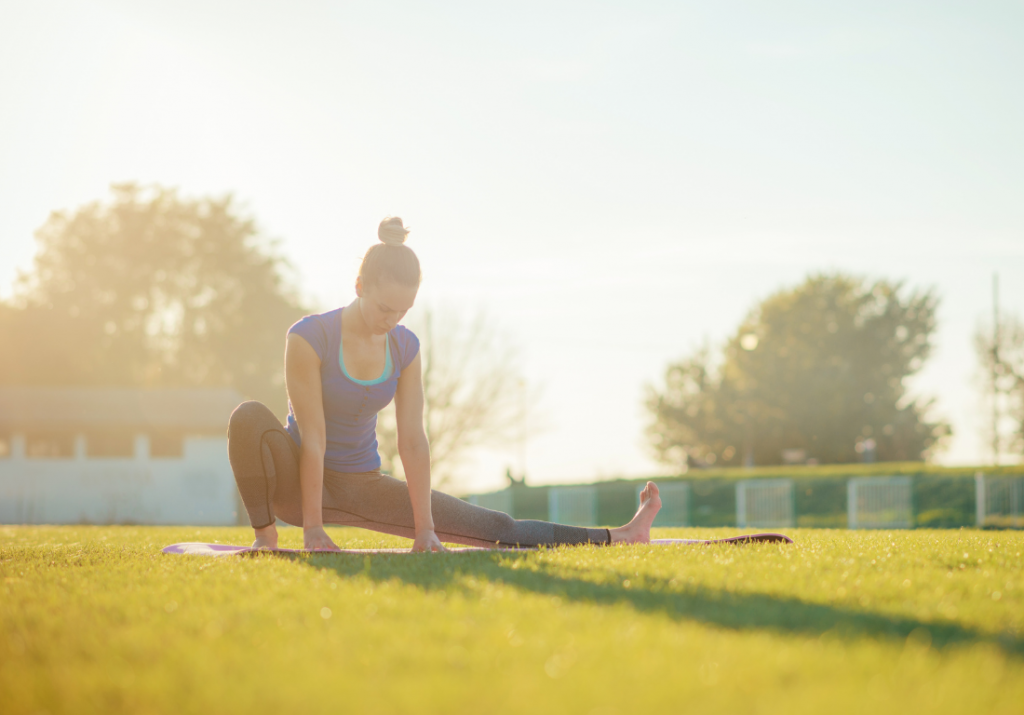
6. Lizard Lunge
- From standing, bend forwards to place your hands on the floor with your knees bent
- Step backwards with one foot and drop down onto that knee so you’re in a lunge position
- Keeping a hand on the floor for support, gently push your front knee out, away from your body to feel a stretch
- Option to lift the back knee for a deeper stretch
To make this more active:
- To add in a muscle contraction, push the front knee in towards your hand and body for a 5-15 second hold, then relax back into the stretch, repeat 3-5 times
- Add movement by keeping the back knee down and rocking the hips backwards whilst straightening the front knee to come into a half split, before coming back into the lizard lunge

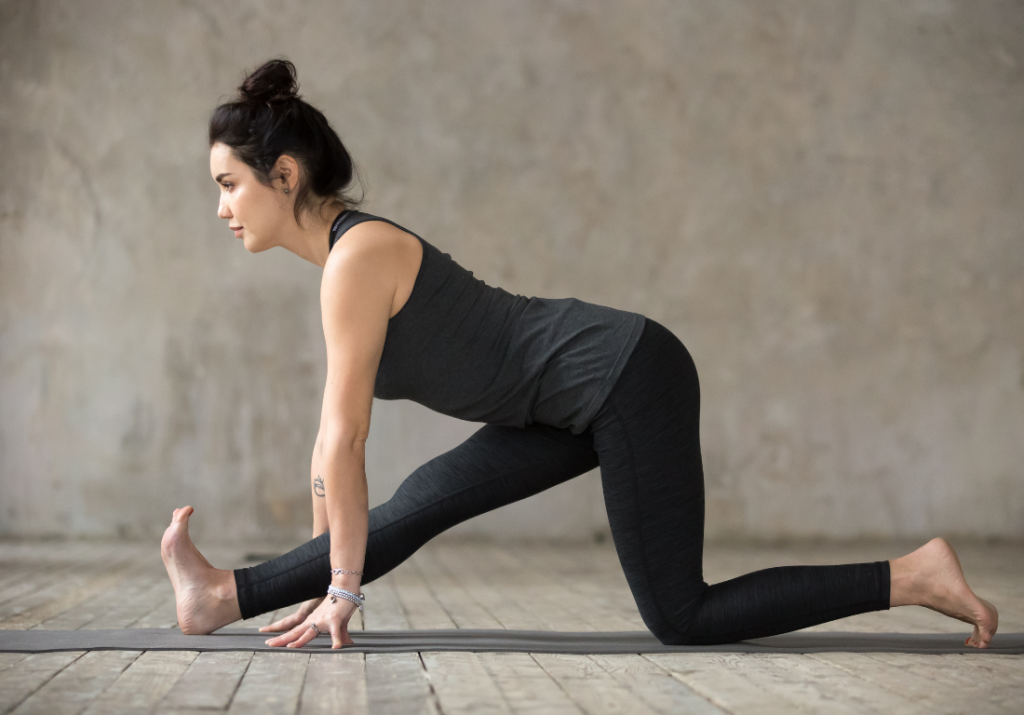
7. Seated Wide-Leg Forward Fold
- Sit on the floor with your hands supporting from behind you
- Take your legs as wide as feels comfortable
- If it’s available to you, sit yourself up tall and take your hands to the floor in front of you
- To take this stretch deeper you can continue to fold your head towards the floor
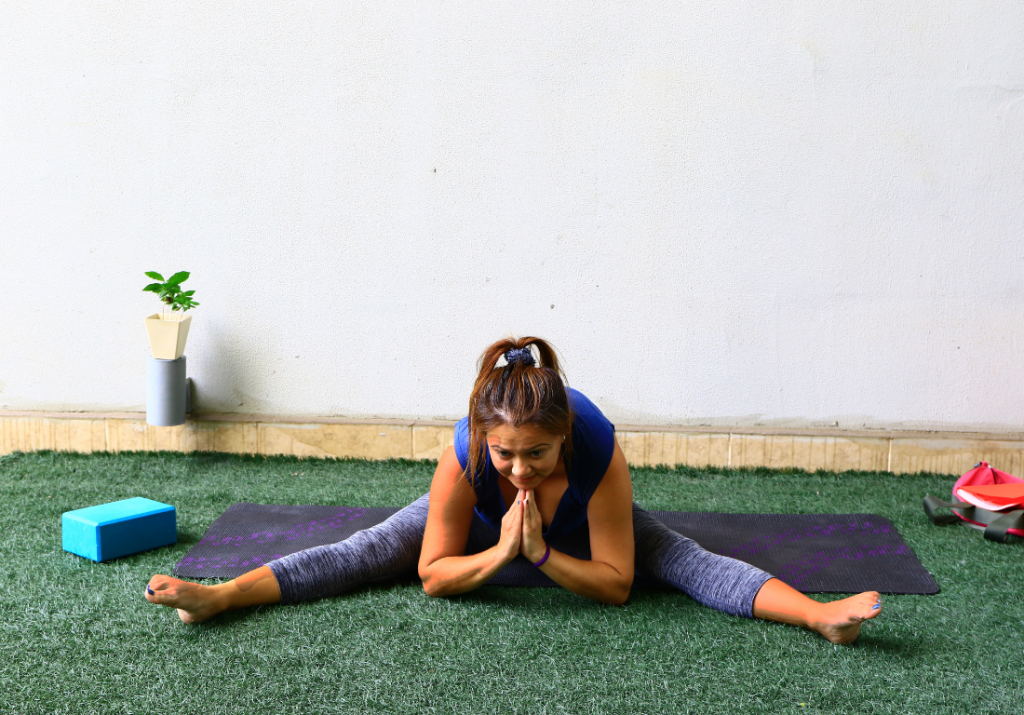
8. Frog Stretch
- Come down onto all fours on the floor with a towel or mat for comfort under the knees if needed
- Take your feet and knees as wide as feels comfortable (make sure it’s not just your knees)
- Allow your hips to drop down towards the floor as far as you’re able, with the option to also drop down onto your elbows
To make this more active:
- Add a muscle contraction by pressing your knees in towards each other against the floor for 5-15 seconds, then relaxing back into the stretch, repeat 3-5 times
- Add movement by staying up on your hands and rocking your body back and forth, taking yourself in and out of the stretch

9. Inverted Wall Adductor Stretch
- Find a wall with plenty of space and lie with your buttocks as close to the wall as possible, as though ‘you’re sitting on the wall’
- Keeping your legs against the wall, allow them to drop out to the side in a wide ‘V’ position to feel the stretch
To make this more active:
- To add movement bring your legs in towards each other and then drop them back out to the stretch
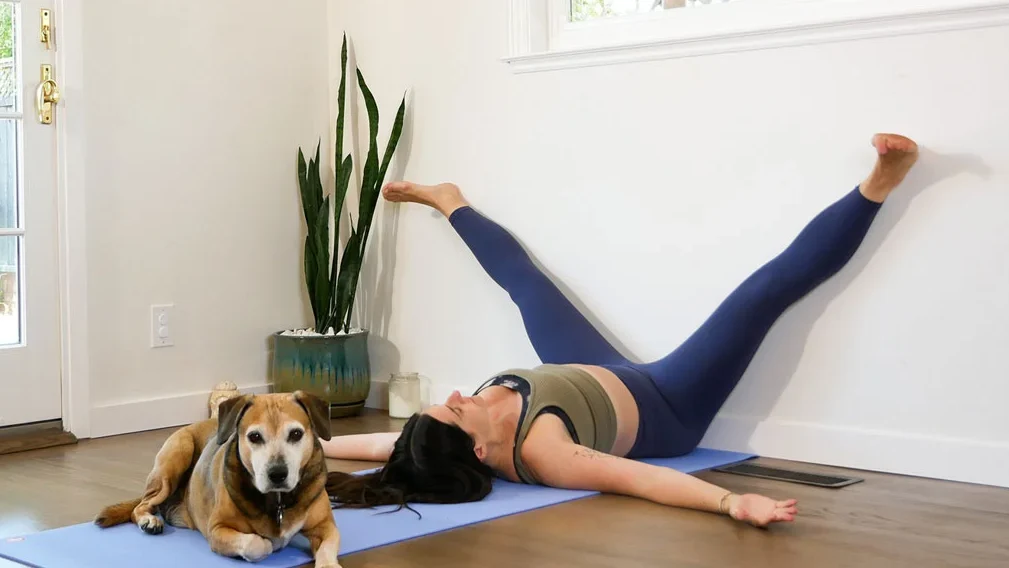
10. Dynamic Sideways Leg Swings
This is a dynamic, movement-based stretch as opposed to a long hold. Do not do this if you have pain or injury. This can be used as a warm-up before sport or a workout.
- Find something to hold on to for support and ensure you have plenty of room to swing your leg
- Begin to swing one leg across your body in front of your other leg, and then swing it out to the side away from your other leg (as opposed to forwards and backwards)
- Explore swinging the leg higher and deeper into the range you have available to you, whilst also trying to keep your pelvis from moving too much
- Continue for 1-2 minutes

Summing Up
So there you have it. My top 10 stretches for adductor tightness as well as a tonne of useful information about groin pain and how stretching actually works. I hope you’ve found an adductor stretch that’s provided you with some relief!
Another read that might interest you: Should you do yoga before or after a workout?
FAQs
Stretching can increase muscle extensibility in both the short and long term, relieving feelings of tightness. Stretching does not help with performance or muscle soreness.
You want to get your legs wide and lean your body forward towards your thighs. Keeping the knees straight will make a stretch more intense.
There is no one ‘best’ adductor stretch as all vary in intensity and may be more or less effective depending on a person’s flexibility.
If you have strained a groin muscle it is best to avoid stretching for at least a week and seek guidance from a rehabilitation professional. Listen to your body and avoid stretches and movements that are painful. Strengthening will be an important part of your recovery to prevent re-injury.
SOURCES
Afonso, J., Claudino, J. G., Fonseca, H., Moreira-Gonçalves, D., Ferreira, V., Almeida, J. M., … & Ramirez-Campillo, R. (2021). Stretching for recovery from groin pain or injury in athletes: A critical and systematic review. Journal of Functional Morphology and Kinesiology, 6(3), 73. https://www.mdpi.com/2411-5142/6/3/73/pdf
Afonso, J., Ramirez-Campillo, R., Moscão, J., Rocha, T., Zacca, R., Martins, A., … & Clemente, F. M. (2021). Strength training is as effective as stretching for improving range of motion: A systematic review and meta-analysis. https://osf.io/preprints/metaarxiv/2tdfm/download
Behm, D. G., Blazevich, A. J., Kay, A. D., & McHugh, M. (2016). Acute effects of muscle stretching on physical performance, range of motion, and injury incidence in healthy active individuals: a systematic review. Applied physiology, nutrition, and metabolism, 41(1), 1-11. Link to article
Borges, M. O., Medeiros, D. M., Minotto, B. B., & Lima, C. S. (2018). Comparison between static stretching and proprioceptive neuromuscular facilitation on hamstring flexibility: systematic review and meta-analysis. European Journal of Physiotherapy, 20(1), 12-19. Link to article
Cayco, C. S., Labro, A. V., & Gorgon, E. J. R. (2019). Hold-relax and contract-relax stretching for hamstrings flexibility: a systematic review with meta-analysis. Physical Therapy in Sport, 35, 42-55. https://www.sciencedirect.com/science/article/abs/pii/S1466853X18300361
Freitas, S. R., Mendes, B., Le Sant, G., Andrade, R. J., Nordez, A., & Milanovic, Z. (2018). Can chronic stretching change the muscle‐tendon mechanical properties? A review. Scandinavian journal of medicine & science in sports, 28(3), 794-806. https://hal.archives-ouvertes.fr/hal-03347403/document
Herbert, R. D., de Noronha, M., & Kamper, S. J. (2011). Stretching to prevent or reduce muscle soreness after exercise. Cochrane database of systematic reviews, (7). https://www.cochranelibrary.com/cdsr/doi/10.1002/14651858.CD004577.pub3/pdf/full
Konrad, A., Nakamura, M., Bernsteiner, D., & Tilp, M. (2021). The accumulated effects of foam rolling combined with stretching on range of motion and physical performance: a systematic review and meta-analysis. Journal of Sports Science & Medicine, 20(3), 535. https://www.ncbi.nlm.nih.gov/pmc/articles/PMC8256518/
Konrad, A., Tilp, M., & Nakamura, M. (2021). A comparison of the effects of foam rolling and stretching on physical performance. A systematic review and meta-analysis. Frontiers in Physiology, 12. https://www.ncbi.nlm.nih.gov/pmc/articles/PMC8514717/
Metgud, S. C., D’Silva, P. V., & Kamat, P. S. (2022). Immediate effect of MWM adductor stretch, myofascial release, and conventional stretching in asymptomatic individuals with hip adductor tightness: A randomized controlled trial. Journal of Bodywork and Movement Therapies, 32, 213-217. https://www.sciencedirect.com/science/article/pii/S1360859222000705
Thorborg, K., Reiman, M. P., Weir, A., Kemp, J. L., Serner, A., Mosler, A. B., & Hölmich, P. (2018). Clinical examination, diagnostic imaging, and testing of athletes with groin pain: an evidence-based approach to effective management. journal of orthopaedic & sports physical therapy, 48(4), 239-249. https://cor-kinetic.com/wp-content/uploads/2018/07/jospt.2018.7850.pdf

